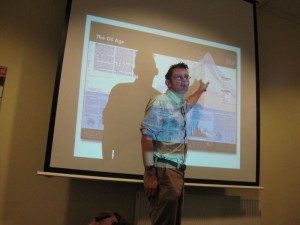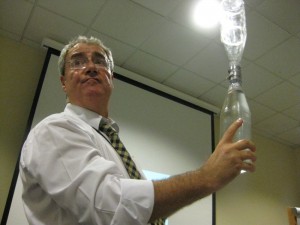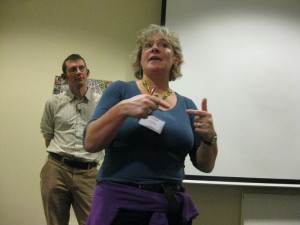4 Dec 2008
From the Transition Cities Conference: Energy Descent Planning Workshop
Energy Descent Plans… The story so far
Presented by Rob Hopkins, John Green & Lucy Neal
#1. Rob Hopkins – Transition Town Totnes
 The Energy Descent Action Plan (EDAP) can be considered a community’s Plan B, developed by the community itself and based on more realistic assumptions than what local authorities, businesses and government departments use. The EDAP can be a tool to plot out what the other side of the peak oil curve, the downhill slope, may look like for a particular community. As the last of the 12 Steps in the transition model, the EDAP is an attempt to weave together the various threads (eg. food or energy or transport initiatives…) that have been running, like mychorriza through the community over the past year or two of the transition process.
The Energy Descent Action Plan (EDAP) can be considered a community’s Plan B, developed by the community itself and based on more realistic assumptions than what local authorities, businesses and government departments use. The EDAP can be a tool to plot out what the other side of the peak oil curve, the downhill slope, may look like for a particular community. As the last of the 12 Steps in the transition model, the EDAP is an attempt to weave together the various threads (eg. food or energy or transport initiatives…) that have been running, like mychorriza through the community over the past year or two of the transition process.
The first EDAP was developed in 2005 in Kinsale, Ireland, as a student project. Since then, there have been EDAPs initiated in Portobello, Edinburgh in Scotland and the Sunshine Coast, Australia (which we are awaiting with baited breath). It is, however, a concept still in development as so far no community has developed a thorough and robust EDAP.
 Transition Town Totnes has been given some funding to develop their EDAP and are currently in the process of developing their Transition Timeline. To offer people a chance to dream about what they may be doing in 2030, what Totnes may look like then, and how they reached that point, a number of events were held. Various activities and exercises have been developed, eg. a fictitious 2030 school reunion, or the creative visioning work done in the local school, known as Transition Tales. The stories, ideas and visions emerging during these activities, are being developed into the Totnes EDAP, and some of them will emege earlier in the Transition Timeline report (due to be published by Transition Network in January). In the EDAP, the timeline will run from 2006 – 2030 (it goes back to 2006 to include trends that were emerging, and that have started since TTT kicked off, key projects, etc), using three or four different scenarios about what transition may look like.
Transition Town Totnes has been given some funding to develop their EDAP and are currently in the process of developing their Transition Timeline. To offer people a chance to dream about what they may be doing in 2030, what Totnes may look like then, and how they reached that point, a number of events were held. Various activities and exercises have been developed, eg. a fictitious 2030 school reunion, or the creative visioning work done in the local school, known as Transition Tales. The stories, ideas and visions emerging during these activities, are being developed into the Totnes EDAP, and some of them will emege earlier in the Transition Timeline report (due to be published by Transition Network in January). In the EDAP, the timeline will run from 2006 – 2030 (it goes back to 2006 to include trends that were emerging, and that have started since TTT kicked off, key projects, etc), using three or four different scenarios about what transition may look like.
By starting with a vision of a positive future of, say, what food and farming will look like in 2030, we can then ‘backcast’ or work backwards to ‘remember’ how we got there, what the key events were, etc. This can be done for different aspects of the community such energy, building & housing, economy & livelihoods, education, governance, art & culture, health & wellbeing, transport, biodiversity, water, waste, community issues, youth issues, etc. Through the narratives that emerge from the community, the EDAP becomes the story of how the community can move through this era. The EDAP is therefore not at all a dry Council plan, but instead a vibrant holiday brochure that entices and compels people to a particular future.
At the same time as the future visioning, Totnes is also attempting to draw a clearer picture of the present situation in the town (eg. through carbon footprinting, a questionnaire on food and agriculture), as well as the history of the town (eg. through oral histories). It’s important to note though, that the EDAP should be seen as an ongoing document that is referred to and revised on a regular basis. Aside from providing a vision and rough timeframe, a community-developed EDAP also identifies areas where campaigning might be appropriate, as it will identify obstacles to its own implementation.
#2. John Green – Transition Nottingham
 John described a day-long team building exercise that provided a useful plan for the most effective projects and organisational issues for the Transition Nottingham hub group. The intention for the day was ‘planning the unplannable’ using what is referred to as the Japanese ‘KJ method’ or ‘affinity methodology’ or ‘Hoshin planning’.
John described a day-long team building exercise that provided a useful plan for the most effective projects and organisational issues for the Transition Nottingham hub group. The intention for the day was ‘planning the unplannable’ using what is referred to as the Japanese ‘KJ method’ or ‘affinity methodology’ or ‘Hoshin planning’.
The first step of the process was to discuss the title of the day’s session until everyone had a clear understanding of the scope of the question. People were then asked to enter into silent brainstorming about the question, writing up each idea or question on individual post-it notes (which were colour-coded to keep track of what was being said by whom), beginning the shift from what may usually be an oral meeting to a visual form of communication.
 Following the brainstorming, each person read out their notes and in turn posted them onto flipcharts that were being labelled according to emerging themes. After the last notes were read out, each person adopted a flipchart/theme and expressed to the group the ideas that had emerged around that theme, these were then discussed so that everyone understood what were the key ideas in that theme, and a new title was developed for that flipchart/theme. These headings in turn placed in a circle, or what John referred to as the ‘clock’, and the connections between these themes were then established through an interrelationship diagram in order understand the cause and effect relationships of the different factors within the community.
Following the brainstorming, each person read out their notes and in turn posted them onto flipcharts that were being labelled according to emerging themes. After the last notes were read out, each person adopted a flipchart/theme and expressed to the group the ideas that had emerged around that theme, these were then discussed so that everyone understood what were the key ideas in that theme, and a new title was developed for that flipchart/theme. These headings in turn placed in a circle, or what John referred to as the ‘clock’, and the connections between these themes were then established through an interrelationship diagram in order understand the cause and effect relationships of the different factors within the community.
#3. Lucy Neal, Transition Tooting
 Lucy gave an account of what has been described as “a romp through the 12 Steps to Transition”. It is an inspirational event which condensed the entire Transition process from “forming an initiating group” through to “creating an Energy Descent Action pathway” into a colourful and collaborative pageant running the course of an afternoon in July 2008 on the South Bank in London.
Lucy gave an account of what has been described as “a romp through the 12 Steps to Transition”. It is an inspirational event which condensed the entire Transition process from “forming an initiating group” through to “creating an Energy Descent Action pathway” into a colourful and collaborative pageant running the course of an afternoon in July 2008 on the South Bank in London.
Lucy described a workshop held as part of London’s Lift Festival during which participants were walked through a whirlwind version of the 12 Steps of Transition for their imaginary town of Anywhere, culminating with the publication of a Transition Anywhere EDAP.
 The workshop not only enabled people working on the various London transition initiatives to meet and find ways to work together and support each other, but also acted as a vibrant and inspiring introduction to the concept of transition, and a taster of the element of playfulness and enthusiasm driving it.
The workshop not only enabled people working on the various London transition initiatives to meet and find ways to work together and support each other, but also acted as a vibrant and inspiring introduction to the concept of transition, and a taster of the element of playfulness and enthusiasm driving it.
A video of the workshop is available from here and will soon be posted onto YouTube.
************************************
 Unfortunately question time for the workshop was limited, but one of the key questions that came up here along with at various other stages of the conference was whether, in the context of cities, EDAPs should be developed at the city-wide level or at local community levels. The view from the speakers was that it is really up to the initiative to find the scale that makes sense to work on, and to be realistic about what you can and can’t do.
Unfortunately question time for the workshop was limited, but one of the key questions that came up here along with at various other stages of the conference was whether, in the context of cities, EDAPs should be developed at the city-wide level or at local community levels. The view from the speakers was that it is really up to the initiative to find the scale that makes sense to work on, and to be realistic about what you can and can’t do.
With many thanks to Amelia for the photos and to Asha for transcribing this session.
Sonya
4 Dec 8:41pm
Thanks for mentioning the Sunshine Coast EDAP. It’s going to be around 250+ pages of ideas, thoughts, action, future plans, small action, big actions, top down, bottom up ideas.
It will be our list of demands, thoughts, ideas, suggestions and also includes what’s already happening (everything the community thought of was included and we’ve found since some of those actions are already happening, but it all goes in)
Since finishing the course and collecting all the responses, we’ve found so many people want to know about TTs and EDAPs, that we’ve tried to make sure as much info as possible is in there, so it also becomes a useful resource for others.
We’ve identified around 10 key target audiences who will be able to use the document.
It’s a big job, and we’re doing it all for free and in our own time, but it’s coming soon.
Our EDAP is for our entire council region, which (after an amalgamation that lead to a super-council) covers more than 300,000 people and over 3,000 square kms.
Our plan was to have an EDAP for every council area – just like Geoff Lawton planned when he started permaculture groups in every council area.
It will go to the community (and we’ll create an education and communication plan to get it out and about as widely as we can), to council, State Government and our Federal Government.
Coming soon to you…
Better get back to it!
Cheers,
Sonya
Klaus
5 Dec 11:11am
Thanks for this Rob. In Kinsale we are planning another Open Space session early next year with a view to rewriting your original EDAP (hope you don’t mind) so you’ve shared some useful tips here.
Much of what was planned in the original Kinsale EDAP hasn’t taken place, or even come close, and other things that weren’t planned for some time, or even at all, have already happened.
As you have said before it was a student project, and without wanting to diminish its importance or its impact, it needs to be more realistic with greater input from members of the wider community.
It’s a big task, but as with all Transition projects, I’m excited by and looking forward to the challenge.
T Kasafir
5 Dec 6:55pm
I’ve never heard of this before. I was given the link by an on-line friend. I have to say that when I started reading here I was puzzled and somewhat confused. Not knowing what it was all about didn’t help any.
However, as I continued reading I think I got the hang of it: You project what people want the future to be, then set about figuring out how to get there, and what you can do to set it in train. Yes?
If so, I like it. I hope it comes to my neck of the woods soon.
Mike
6 Dec 11:35am
Hi Rob and all you other Transitioneers,
I’d like to use the oportunity to congratulate and thank you for the work you are doing. When I read the Handbook I was moved to tears several times to see themes that have caused me deep existential anxiety for most of life adressed courageously and even cheerfully. My deepest gratitude for that.
I’ve been running into difficulties trying to tell others about the Transition idea, and although I will educate myself more as time goes by, it would be so helpful to have, for instance, a website to point people to, where they could find a crisp, maybe multimedia, presentation of the core concepts. As T Kasafir wrote in the previous comment, it can be quite enigmatic to the uninitiated, Sonya in the first comment even wrote about the 250 pages of material she’s planning to unleash. I see the danger of it becoming an ivory tower thing after all. I suppose this will be partly adressed by the upcoming film that I’m very much looking forward to. But maybe there are some advertising, or communications design people out there that could boil it down to the essence and present it in a flashy, bite-size format for the benefit of the ignorant, the innocent and the stupid, and then I’d have an internet link I could mention to the guy standing beside me at the bus-stop.
Best wishes
Mike
Sonya
6 Dec 9:24pm
Hi,
I started learning about this two years ago when I first saw the Kinsale EDAP. I also heard David Holmgren speak on relocalisation in an energy descent future around the same time.
Doing lots of research is important, but equally important is actually doing it.
EDAPs are protected I feel from becoming an ivory tower thing by remaining the property of the community. Our 250 pages is a series of chapters, some relevant to individuals – one pagers about how to get started. Others are aimed at community members who want to start a Transition Town initiative in their local area – they are more in-depth.
The document belongs to the community and people are encouraged to be part of it, now matter how big or small their contribution is – and we are all constrained by time, family, finances and availability.
The EDAP will continually be added to, reviewed, enhanced, measured and so on. Each opportunity is an opportunity for people to become involved.
Put simply, it’s all about moving from oil dependency to local resilience. Looking at all the ways fossil fuels and energy affect our lives; eg our food supply, water supply, waste management, built environment and housing situation… it goes on and on. Take each of those areas and imagine how you could build resilience and strength and diversity into them. To get off the oil addiction.
It’s also about tackling climate change and peak oil, together.
We have 250 pages because we are a region of 300,000 people to cover plus the community had a lot to say! Ours is the first in Australia so it also needed to stand alone and comprehensively explain all these great ideas to new readers.
We’re finding the best way to introduce people to the idea is through face to face workshops. We have one coming up next weekend which quickly filled with 60 people attending.
Cheers,
Sonya